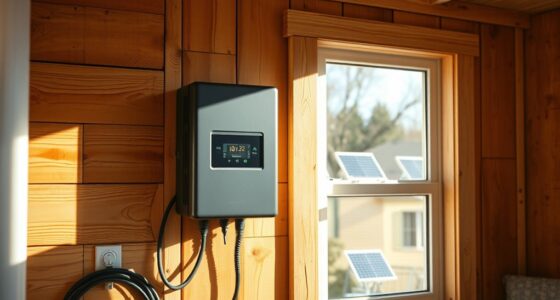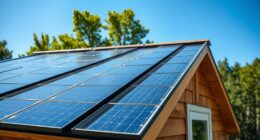I am fed up with these annoying small brown ants infiltrating my home. They appear to be all over the place, crawling on my surfaces and infiltrating my pantry.
But fear not, because I’ve done my research and I’m here to share the best methods to get rid of these little pests.
From natural remedies to safe chemical solutions, I’ll guide you step-by-step on how to eliminate these tiny brown ants for good.
Say goodbye to the ant invasion and hello to a pest-free home.

Key Takeaways
- Observe ant trails and look for ant colonies in dark and moist areas
- Use natural remedies such as vinegar, cinnamon powder, and diatomaceous earth to repel and eliminate tiny brown ants
- Safely and effectively use appropriate chemicals to combat tiny brown ants, following instructions for maximum effectiveness and safety
- Prevent future infestations by keeping food sealed, eliminating food sources, sealing entry points, and implementing long-term ant control strategies
Identifying the Type of Ants in Your House
I can easily determine the species of ants in my house by observing their behavior and physical characteristics.
When it comes to identifying the type of ants infesting your home, there are some common signs to look out for.
One of the most obvious signs is the presence of ant trails, which are visible lines of ants moving back and forth between their nest and food sources.
Another sign is the sighting of ant colonies, usually found in dark and moist areas such as under sinks or behind appliances.

In terms of physical characteristics, different ant species vary in size, color, and shape.
Understanding the Behavior and Habits of Tiny Brown Ants
There are a few key behaviors and habits that tiny brown ants exhibit which can help homeowners better understand and address their presence. Understanding ant behavior and habits is crucial in effectively dealing with an infestation.
Tiny brown ants, also known as odorous house ants, are typically attracted to sugary foods and moisture. They leave behind pheromone trails to communicate with other ants, leading to the formation of long trails that can be seen in homes.
These ants are known for their persistence in finding food sources and their ability to squeeze through tiny cracks and crevices. They’re also known to build their nests close to food sources, making it important to identify and eliminate these sources.

By understanding these behaviors and habits, homeowners can take the necessary steps to prevent and address ant infestations.
Now that we’ve a better understanding of the behavior and habits of tiny brown ants, let’s explore some natural remedies to eliminate them.
Natural Remedies to Eliminate Tiny Brown Ants
One effective way to naturally eliminate tiny brown ants is by regularly cleaning and decluttering your home. Ants are attracted to food sources and crumbs left behind, so keeping your living space clean can help deter them. In addition to cleanliness, there are other natural remedies you can try to eliminate these pests.
| Remedies | Description | Benefits |
|---|---|---|
| Vinegar | Mix equal parts vinegar and water in a spray bottle and spray areas where ants are present. The strong smell repels them. | Affordable and non-toxic solution. |
| Cinnamon | Sprinkle cinnamon powder along ant trails or areas where they enter your home. It disrupts their scent trails and deters them. | Safe for use around children and pets. |
| Diatomaceous Earth | Sprinkle diatomaceous earth around ant-infested areas. It damages their exoskeletons and dehydrates them. | Effective in killing ants without harming beneficial insects. |
It’s important to note that the impact of climate change on ant populations can vary. Some species may thrive in warmer temperatures, while others may face challenges. By implementing these natural remedies and creating an environment that is less attractive to ants, you can help manage their presence in your home.

Using Chemicals Safely and Effectively Against Tiny Brown Ants
To safely and effectively combat tiny brown ants in your house, it’s essential to carefully choose and apply appropriate chemicals. When using chemical ant treatments, it’s important to follow proper disposal methods to ensure the safety of your family and the environment.
After using the chemicals, make sure to dispose of any leftover products according to the instructions on the label. This may involve sealing them in a bag and placing them in a designated hazardous waste disposal area.
Additionally, it’s crucial to take protective measures to safeguard your pets and children. Keep them away from treated areas until the chemicals have dried completely, and store the products in a secure location out of their reach.
Always read and follow the instructions on the label to ensure maximum effectiveness and safety when using chemical ant treatments.

Preventing Future Infestations of Tiny Brown Ants
I can prevent future infestations of tiny brown ants in my house by implementing a few simple strategies. Here are some long-term strategies for ant control:
-
Keep food sealed and stored properly: Ants are attracted to food sources, so make sure to keep your pantry and kitchen clean and free of crumbs. Store food in airtight containers to prevent ants from accessing it.
-
Clean up spills and crumbs immediately: Any food residue left out can attract ants. Wipe down surfaces and vacuum regularly to eliminate potential food sources.
-
Seal entry points: Ants can enter through even the smallest cracks and gaps. Seal any openings around windows, doors, and pipes to prevent ants from finding their way inside.

-
Trim vegetation: Ants often use plants and trees as bridges to access your home. Trim back branches and keep vegetation away from your house to reduce easy access for ants.
-
Practice good sanitation: Regularly clean your garbage cans and dispose of trash properly. Ants are attracted to odors, so maintaining cleanliness will help deter them.
Frequently Asked Questions
How Do I Get Rid of Ants in My Garden?
I can help with garden ant control. Using natural ant repellents like cinnamon or peppermint can deter ants from your garden. Applying these around the affected areas should help keep them away.
Can I Use Vinegar to Kill Tiny Brown Ants?
Yes, vinegar can be used to kill tiny brown ants. It is one of many alternative natural remedies for ant control. However, it’s important to note that vinegar may not be as effective as other methods.

What Are the Signs of a Severe Ant Infestation?
When dealing with a severe ant infestation, it’s important to recognize the signs, such as large numbers of ants, visible ant trails, and damage to food or property. If you have a severe ant problem, it’s best to seek professional help for effective eradication.
Are There Any Health Risks Associated With Tiny Brown Ants?
Tiny brown ants in your house can pose health risks, such as contaminating food. By maintaining cleanliness, sealing entry points, and using ant baits, you can prevent their infestation and protect your health.
How Long Does It Take for the Natural Remedies to Eliminate Tiny Brown Ants to Work?
The effectiveness of natural remedies in eliminating tiny brown ants can vary depending on the specific remedy used. It’s important to note that the timeline for results can also vary, ranging from a few days to several weeks.
Conclusion
In conclusion, identifying the type of ants in your house is crucial in order to effectively eliminate them. By understanding their behavior and habits, you can implement natural remedies or use chemicals safely and effectively.

However, some may argue that preventing future infestations is impossible. While it may require ongoing efforts, implementing preventive measures such as sealing entry points and keeping a clean environment can significantly reduce the chances of tiny brown ants returning to your house.
I’m Theodore, and I love tiny houses. In fact, I’m the author of Tiny House 43, a book about tiny houses that are also tree houses. I think they’re magical places where imaginations can run wild and adventures are just waiting to happen.
While tree houses are often associated with childhood, they can be the perfect adult retreat. They offer a cozy space to relax and unwind, surrounded by nature. And since they’re typically built on stilts or raised platforms, they offer stunning views that traditional homes simply can’t match.
If you’re looking for a unique and romantic getaway, a tree house tiny house might just be the perfect option.










